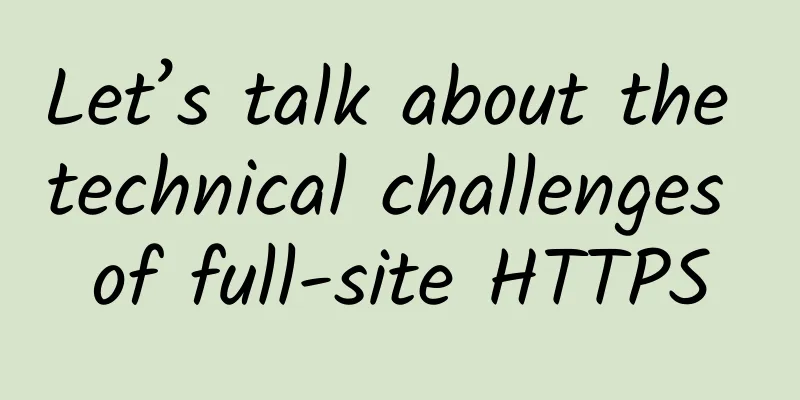Let’s talk about the technical challenges of full-site HTTPS

|
The article I wrote recently discussed the issue of data transmission security, and the last part mentioned the solution to data transmission security through HTTPS. Then a new question arises: what technical problems may we encounter in the process of implementing HTTPS throughout the site? So today, let's do the math together and sort out the technical costs.
Preparation
Common solutions for CDN using https are:
Performance Challenges After making the above technical preparations, we must also be aware of the performance issues that come with implementing HTTPS: 1. Network time consumption increases. Simply put, more handshakes are required, network time consumption becomes longer, and it takes some time for users to jump from http to https. For the optimization of this area, there are optimization solutions such as Session ticket or Session Cache, but each has its own advantages and disadvantages. 2. The calculation time increases, and better machine performance is required. https needs to perform an additional RSA check. The main ways to optimize this area are to adopt the latest openssl protocol, use hardware acceleration, give priority to ECC keys, etc. Security Challenges Regarding this area, common security risks include: downgrade attacks and renegotiation attacks. For the former, the attacker forges or modifies the "client hello" message, causing the client and server to use a relatively weak encryption suite or protocol to complete the communication. For the renegotiation attack, the attacker takes advantage of the weak security algorithm after negotiation to try to steal the transmission content, and can continuously initiate full handshake requests, triggering the server to perform high-intensity calculations and causing service denial. Of course, with the efforts of infrastructure vendors or cloud vendors, general business users like us don’t need to worry about security issues at the protocol layer. The purpose of my raising this issue here is to make it clear that security issues can never be relaxed. Final Thoughts Switching to HTTPS is an inevitable trend. I believe that more and more sites will join in, and once completed, it will bring us huge benefits. For our technical team, before implementation, we must consider the technical costs behind it, make corresponding technical reserves, and prepare the online process of switching from HTTP to HTTPS to ensure that everything is foolproof. |
<<: 10+ Apps You Must Uninstall During the National Day Holiday
>>: 2017 Big Data Festival is coming in October, iResearch A10 Summit will open on the 27th
Recommend
User operation: operation skills and channel establishment for user feedback
In operational work, there is a position that req...
Two aspects to explore how to write product comparison copy to be more attractive
Based on different comparison references, the art...
China Maritime Day丨If a country wants to be prosperous and strong, it cannot ignore the ocean...See how the People's Navy sails into the deep blue and strives for maritime strength!
"If a country wants to be rich and strong, i...
Use these 5 points to increase product user growth!
As the Internet's traffic dividend fades, gro...
What is the secret to being a successful Tuiyouqian (Youqianhua partner)? How do ordinary people fight back?
Three secrets to making money: 1. Don’t look at i...
Dingxiang Mama's "Breastfeeding Guide"
Dingxiang Mama's "Breastfeeding Guide&qu...
After reading this article, don’t say curling is just mopping the floor anymore!
Mixed Knowledge Specially designed to cure confus...
From Pechoin to Momo, is soft advertising better or hard advertising?
From Pechoin to Momo, with the same budget and th...
How to use email marketing automation tools to enhance software company sales?
SaaS company sales are divided into "interna...
How to reduce APP uninstall rate? Here are seven ways!
The mobile application market is now a crowded ma...
How much money is appropriate to invest in WeChat promotion? How is it charged? What types of promotions are there?
Recently, fans often ask me, how much money is ap...
The core logic of promotion on channels such as Baidu and Douban
Previously we talked about the definition of thir...
What are the Kuaishou live broadcast promotion techniques? A comprehensive review of Kuaishou live broadcast promotion skills
Live streaming is very common on Kuaishou. Now on...
Hot Review | Nankai professor's resume is trending, netizens: It's so funny
"Hotspot Review | Major Technology Events of...









